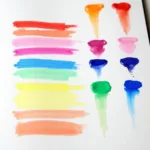The question of God’s color is a fascinating one, sparking curiosity and prompting deep contemplation. While religious texts and spiritual teachings rarely focus on a literal depiction of God’s physical attributes, including color, the concept itself opens up a rich tapestry of interpretations, symbolism, and cultural perspectives.
Instead of searching for a definitive answer to “What Is The Color Of God,” let’s explore the diverse ways this question manifests across various beliefs, the symbolism associated with different colors within religious contexts, and the broader implications of associating colors with the divine.
Colors and Their Significance in Religious Contexts
Throughout history, different cultures and religions have attributed symbolic meanings to colors, often weaving them into their narratives, rituals, and artistic expressions.
- White: In many cultures, white represents purity, innocence, and the divine. It is often associated with spiritual enlightenment, holiness, and transcendence. Think of the white robes worn by priests or the white doves symbolizing peace.
- Gold: Gold often symbolizes divinity, majesty, and glory. Its association with precious metals further links it to themes of power, wealth, and the eternal. Consider the golden halos depicted in religious art or the gilded decorations adorning sacred spaces.
- Blue: Blue, the color of the sky and the sea, can represent vastness, infinity, and the transcendent nature of God. It can also symbolize peace, serenity, and spiritual contemplation. In some traditions, blue is associated with divine protection and guidance.
- Green: Green, the color of nature, represents life, renewal, and growth. It can symbolize hope, fertility, and the sustaining power of the divine.
God’s Color: Beyond the Literal
Asking “what is the color of god” might be missing the point. Many religious traditions emphasize that God is a spirit, beyond human comprehension and physical form. Assigning a specific color to God could be seen as limiting or attempting to confine the infinite to a finite characteristic.
Instead of seeking a literal answer, perhaps a more meaningful approach is to explore how the concept of God’s color invites us to think about:
- The diversity of human experience: Just as there are countless colors in the spectrum, there are countless ways to experience and connect with the divine.
- The limitations of language: Human language, even when trying to express the profound, inevitably falls short. Color, in this context, might be best understood as a metaphor for the inexpressible.
- The personal nature of faith: Ultimately, one’s understanding of God, including any associated colors, is deeply personal and shaped by individual beliefs and experiences.
Beyond a Single Hue: Embracing the Spectrum of Faith
While a definitive answer to “what is the color of god” remains elusive and perhaps intentionally so, the exploration itself leads us on a thought-provoking journey. By delving into the symbolism of colors, recognizing the limitations of human perception, and acknowledging the deeply personal nature of faith, we gain a richer understanding of the multifaceted ways humans relate to the divine.
If you’re curious about the colors associated with specific deities or want to delve deeper into the symbolism of color in different religions, here are some related topics to explore:
- How many colors are in god’s rainbow?
- What is god favorite color
- [What are the 3 colors of god](https://colorbox.com.vn/what-are-the-3-colors-of god/)
Ultimately, the “color of God” might be less about a single hue and more about the vibrant tapestry of beliefs, interpretations, and experiences that make up the spectrum of human spirituality.
